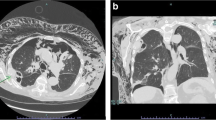Abstract
Empyema and complicated pleural effusion represent common medical problems. Current treatment options are multiple. The purpose of this study was to access the outcome of image-guided, small-bore catheter drainage of empyema and effusion. We evaluated 93 small-bore catheters in 82 patients with pleural effusion (n = 30) or empyema (n = 52), over a 2-year period. Image guidance was with ultrasound (US; n = 56) and CT (n = 37). All patients were followed clinically, with catheter dwell times, catheter outcome, pleural fluid outcome, reinsertion rates, and need for urokinase or surgery recorded. Ninety-three small-bore chest drains (mean=10.2 Fr; range, 8.2–12.2 Fr) were inserted, with an average dwell time of 7.81 days for empyemas and 7.14 days for effusions (p > 0.05). Elective removal rates (73% empyema vs 86% effusions) and dislodgement rates (12% empyema vs 13% effusions) were similar for both groups. Eight percent of catheters became blocked and 17% necessitated reinsertion in empyemas, with no catheters blocked or requiring reinsertion in effusions (p < 0.05). Thirty-two patients (51%) required urokinase in the empyema group, versus 2 patients (6%) in the effusion group (p < 0.05). All treatment failures, requiring surgery, occurred in the empyema group (19%; n = 12; p < 0.05). In conclusion, noninfected pleural collections are adequately treated with small-bore catheters, however, empyemas have a failure rate of 19%. The threshold for using urokinase and larger-bore catheters should be low in empyema.

Similar content being viewed by others
References
Colice GL, Curtis A, Deslauriers J, et al. (2000) Medical and surgical treatment of parapneumonic effusions: an evidence-based guideline. Chest 118:1158–1171
Hipppocrates (1847) Genuine works of Hippocrates. Anderer F, trans. Syndeham Society, London, UK: 1847
Horsley A, Jones L, White J, Henry M (2006) Efficacy and complications of small-bore, wire guided chest drains. Chest 130:1857–1863
Marom EM, Palmer SM, Erasmus JJ, et al. (2003) Pleural effusions in lung transplant recipients: image-guided small-bore catheter drainage. Radiology 228:241–245
Silverman SG, Mueller PR, Saini S, et al. (1988) Thoracic empyema: management with image-guided catheter drainage. Radiology 169:5–9
Davies CW, Gleeson FV, Davies RJ (2003) BTS guidelines for the management of pleural infection. Thorax 58 (Suppl 2):ii18–ii28
Hyde J, Sykes T, Graham T (1997) Reducing morbidity from chest drains. BMJ 314:914–915
Balfour-Lynn IM, Abrahamson E, Cohen G, et al. (2005) BTS guidelines for the management of pleural infection in children. Thorax 60:1–21
Stavas J, Van Sonnenberg E, Casola G, et al. (1987) Percutaneous drainage of infected and noninfected pleural thoracic fluid collections. J Thorac Imaging 2:80–87
Light RW, Girard WM, Jenkinson SG, et al. (1980) Parapneumonic effusions. Am J Med 69:507–512
King S, Thompson A (2002) Radiological perspectives in empyema. Br Med Bull 61:203–214
Yang PC, Luh KT, Chang DB, et al. (1992)Value of sonography in determining the nature of pleural effusion: analysis of 320 cases. AJR 159:29–33
Eibenberger KL, Dock WI, Ammann ME, et al. (1994) Quantification of pleural effusions: sonography versus radiography. Radiology 191:681–684
Ulmer JL, Choplin RH, Reed JC (1991) Image-guided catheter drainage of the infected pleural space. J Thorac Imaging 6:65–73
Westcott JL (1985) Percutaneous catheter drainage of pleural effusion and empyema. AJR 144:1189–1193
Merriam MA, Cronan JJ, Dorfman GS, et al. (1988) Radiologically guided percutaneous catheter drainage of pleural fluid collections. AJR 151:1113–1116
Kearney SE, Davies CWH, Davies RJO, et al. (2000) Computed tomography and ultrasound in parapneumonic effusions and empyema. Clin Radiol 55:542–545
Aquino SL, Webb SR, Gushiken BJ (1994) Pleural exudates and transudates: diagnosis with contrast-enhanced CT. Radiology 192:803–808
Waite RJ, Carbonneau RJ, Balikian JP, et al. (1990) Parietal pleural changes in empyema: appearances at CT. Radiology 175:145–150
Takasugi JE, Godwin JD, Teefey SA (1991)The extrapleural fat in empyema: CT appearance. Br J Radiol 64:580–583
Moulton JS, Benkert RE, Weisiger KH, Chambers JA (1995) Treatment of complicated pleural fluid collections with image-guided drainage and intracavitary urokinase. Chest 108:1252–1259
Parulekar W, Di Primio G, Matzinger F, Dennie C, Bociek G (2001) Use of small-bore vs large-bore chest tubes for treatment of malignant pleural effusions. Chest 120:19–25
Shankar S, Gulati M, Kang M, Gupta S, Suri S (2000) Image-guided percutaneous drainage of thoracic empyema: Can sonography predict the outcome? Eur Radiol 10:495–499
Park JK, Kraus FC, Haaga JR (1993) Fluid flow during percutaneous drainage procedures: an in vitro study of the effects of fluid viscosity, catheter size, and adjunctive urokinase. AJR 160:165–169
Tillett WS, Sherry S (1949) The effect in patients of streptococcal fibrinolysin (streptokinase) and streptococcal desoxyribonuclease on fibrinous, purulent, and sanguinous pleural exudations. J Clin Invest 28:173–190
Bilaceroglu S, Cagerici U, Cakan A (1997) Management of complicated parapneumonic pleural effusions with image-guided drainage and intrapleural urokinase or streptokinase: a controlled randomized trial. Eur Respir J 10:325S
Davies RJO, Traill ZC, Gleeson FV (1997) Randomized controlled trial of intra-pleural streptokinase in community acquired pleural infection. Thorax 52:416–421
Bouros D, Schiza S, Tzanakis N, et al. (1999) Intrapleural urokinase versus normal saline the treatment of complicated parapneumonic effusions and empyema. Am J Respir Crit Care Med 159:37–42
Thompson AH, Hull J, Kumar R, et al. (2002) A randomized trial of intrapleural urokinase in the treatment of childhood empyema. Thorax 57:343–347
Chapman SJ, Davies RJ. (2004) The management of pleural space infections. Respirology ;9:4–11
Temes RT, Follis F, Kessler RM, et al. (1996) Intrapleural fibrinolytics in management of empyema thoracis. Chest 110:102–106
Porter J, Banning AP (1998) Intrapleural streptokinase. Thorax 53:720
Godley PJ, Bell RC (1984) Major hemorrhage following administration of intrapleural streptokinase. Chest 86:486–487
Alfageme I, Vazquez R (1997) Ventricular fibrillation after intrapleural urokinase. Intens Care Med 23:352
Bouros D, Tzouvelekis A, Antoniou KM, Heffner JE (2007) Intrapleural fibrinolytic therapy for pleural infection. Pulm Pharmacol Ther 20:616–626
Author information
Authors and Affiliations
Corresponding author
Rights and permissions
About this article
Cite this article
Keeling, A.N., Leong, S., Logan, P.M. et al. Empyema and Effusion: Outcome of Image-Guided Small-Bore Catheter Drainage. Cardiovasc Intervent Radiol 31, 135–141 (2008). https://doi.org/10.1007/s00270-007-9197-0
Received:
Revised:
Accepted:
Published:
Issue Date:
DOI: https://doi.org/10.1007/s00270-007-9197-0




